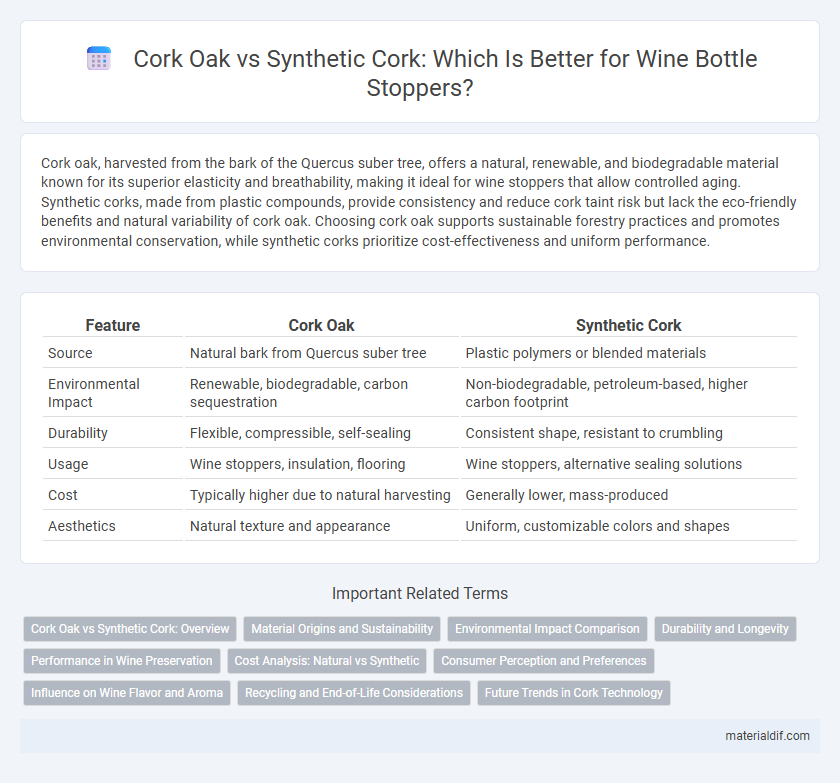Cork oak, harvested from the bark of the Quercus suber tree, offers a natural, renewable, and biodegradable material known for its superior elasticity and breathability, making it ideal for wine stoppers that allow controlled aging. Synthetic corks, made from plastic compounds, provide consistency and reduce cork taint risk but lack the eco-friendly benefits and natural variability of cork oak. Choosing cork oak supports sustainable forestry practices and promotes environmental conservation, while synthetic corks prioritize cost-effectiveness and uniform performance.
Table of Comparison
| Feature | Cork Oak | Synthetic Cork |
|---|---|---|
| Source | Natural bark from Quercus suber tree | Plastic polymers or blended materials |
| Environmental Impact | Renewable, biodegradable, carbon sequestration | Non-biodegradable, petroleum-based, higher carbon footprint |
| Durability | Flexible, compressible, self-sealing | Consistent shape, resistant to crumbling |
| Usage | Wine stoppers, insulation, flooring | Wine stoppers, alternative sealing solutions |
| Cost | Typically higher due to natural harvesting | Generally lower, mass-produced |
| Aesthetics | Natural texture and appearance | Uniform, customizable colors and shapes |
Cork Oak vs Synthetic Cork: Overview
Cork oak, harvested from Quercus suber trees primarily in Mediterranean regions, offers a sustainable and biodegradable alternative to synthetic corks made from plastic polymers. Cork oak's cellular structure provides superior elasticity and oxygen permeability, contributing to optimal wine maturation and preservation compared to synthetic options that often lack these natural properties. The environmental benefits of cork oak extend to carbon sequestration and habitat preservation, whereas synthetic corks pose challenges in recyclability and ecological impact.
Material Origins and Sustainability
Cork oak (Quercus suber) is a renewable natural resource harvested from the bark of cork oak trees primarily found in Mediterranean regions, supporting biodiversity and carbon sequestration. Synthetic corks, made from plastic polymers, rely on petrochemical processes that contribute to carbon emissions and pose recycling challenges. The sustainable harvesting of cork oak bark promotes forest preservation and reduces environmental impact compared to the fossil fuel-dependent production of synthetic alternatives.
Environmental Impact Comparison
Cork oak harvesting supports biodiversity and carbon sequestration, as the trees absorb approximately 14 million tons of CO2 annually in cork oak forests. In contrast, synthetic cork production involves petroleum-based materials, generating higher carbon emissions and contributing to microplastic pollution. The natural biodegradability and renewability of cork oak make it a more sustainable option compared to synthetic alternatives with longer decomposition times and greater environmental footprints.
Durability and Longevity
Cork oak stoppers exhibit exceptional durability and longevity due to their natural cellular structure, which allows them to maintain elasticity and prevent wine oxidation for decades. Synthetic corks, made from plastic compounds, can offer consistent performance but often degrade faster, leading to potential leakage or off-flavors within a few years. The biodegradability and natural resilience of cork oak make it a preferred choice for long-term wine storage and aging.
Performance in Wine Preservation
Cork oak offers superior oxygen permeability that enhances wine aging by allowing micro-oxygenation, preserving aroma and flavor complexity over time. Synthetic corks provide consistent sealing but often lack the nuanced breathability, which can lead to either premature oxidation or reduction, impacting wine quality negatively. Studies indicate natural cork's cellular structure better maintains wine integrity through prolonged storage compared to most synthetic alternatives.
Cost Analysis: Natural vs Synthetic
Natural cork produced from cork oak trees generally incurs higher initial costs due to sustainable harvesting methods and limited supply, but it offers superior environmental benefits and a renewable source. Synthetic corks, fabricated from plastic and rubber composites, typically feature lower upfront costs and consistent quality, making them an economical choice for large-scale bottling. Over time, natural corks may yield better market value and consumer preference, whereas synthetic alternatives reduce variability and potential spoilage risks.
Consumer Perception and Preferences
Consumer perception of cork oak versus synthetic cork often favors cork oak due to its natural origin, sustainability, and traditional quality associated with wine preservation. Studies indicate that wine enthusiasts value cork oak for its role in promoting wine aging and flavor integrity, whereas synthetic cork is preferred by some for its consistency and absence of cork taint. Market research reveals a growing segment of consumers who prioritize environmental impact, reinforcing cork oak's appeal as a renewable resource in the beverage industry.
Influence on Wine Flavor and Aroma
Cork oak stoppers allow micro-oxygenation, enhancing wine complexity and preserving delicate aromas, while synthetic corks often limit this interaction, potentially resulting in less nuanced flavor profiles. The natural porosity of cork oak supports aging processes that develop richer, more balanced wine characteristics compared to synthetic alternatives. Studies reveal that wines sealed with cork oak typically exhibit superior aromatic intensity and flavor depth, crucial factors for premium wine quality.
Recycling and End-of-Life Considerations
Cork oak bark is fully biodegradable and recyclable, making it an eco-friendly choice with natural compostability that reduces landfill waste. Synthetic corks, often made from plastic or other non-biodegradable materials, pose significant challenges in recycling due to their mixed polymer composition, leading to higher environmental impact at end-of-life. Cork oak recycling programs efficiently transform used corks into insulation, flooring, and other products, highlighting superior sustainability compared to synthetic alternatives.
Future Trends in Cork Technology
Cork oak harvesting remains a sustainable practice supporting biodiversity and climate mitigation, while synthetic cork innovations target enhanced durability and wine preservation. Emerging trends emphasize biodegradable composites and nanotechnology to improve performance and environmental impact of cork closures. The integration of smart sensors within cork stoppers promises to revolutionize quality control in wine aging and storage.
cork oak vs synthetic cork Infographic

 materialdif.com
materialdif.com